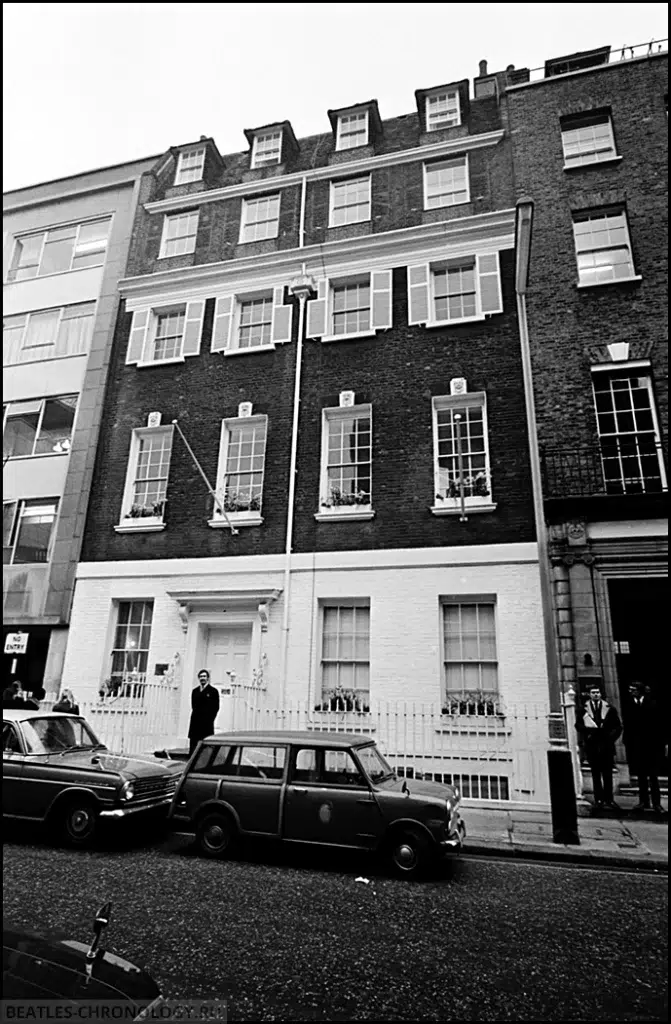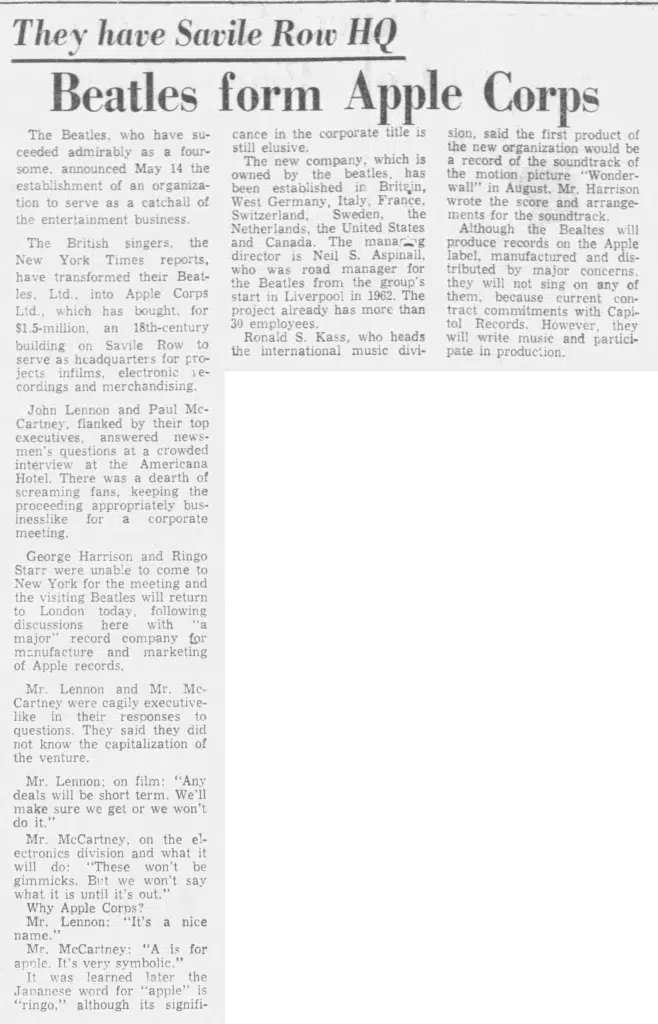
May 1968
The Beatles acquire the property at 3 Savile Row, London
Last updated on October 4, 2024

May 1968
Last updated on October 4, 2024
Location: 3 Savile Row, London, UK
Article Apr 19, 1968 • Apple publishes an ad to find new talent
Article May 1968 • Paul McCartney meets with duo Drew And Dy
Article May 1968 • The Beatles acquire the property at 3 Savile Row, London
Article May 05, 1968 • Mary Hopkin appears on "Opportunity Knocks" TV show
In May 1968, the Beatles purchased a five-storey building at 3 Savile Row, London, for £500,000. They relocated their offices from 95 Wigmore Street to Savile Row on July 15, 1968.
Barry Miles, in “The Beatles Diary Volume 1: The Beatles Years,” records the purchase date by as June 22, 1968. However, a press article dated May 24, 1968, references 3 Savile Row, implying the acquisition occurred in May.
3 Savile Row served as Apple’s headquarters until 1972 and remained in use as a recording studio until May 1975. The Beatles eventually sold the property in October 1976.
3 Savile Row in London, a Georgian mansion, was home to many prominent figures prior to The Beatles. Notable residents included Admiral John Forbes, known for his refusal to sign Admiral Byng’s death warrant, and General Robert Ross, who orchestrated the burning of Washington D.C. in 1814. The building is also linked to the Duke of Wellington and has been significant in British military and political history. Lady Hamilton, known as Admiral Nelson’s lover, is believed to have resided there, possibly renting the property before General Ross. For more details, visit Wicked William’s article.
I had asked Neil [Aspinall] to look for a great London building. And he found it, 3 Savile Row, Lady Hamilton’s London residence, which Nelson bought for her. I thought, if nothing else, that’s a good London building.
Paul McCartney – From “Paul McCartney: Many Years from Now” by Barry Miles, 1997
The original idea that was put to me was that they would buy an estate and we’d all live on it. There’d be a big dome in the middle, which would be Apple, and then there’d be four corridors leading to four large houses, one for John, one for Paul, one for George and one for Ringo. And around the estate, there would be other houses, sort of gardener’s domes, and we’d live in there. One way and another a good time would be had by all. Well, the reality was that they did not try and buy an estate because, land being what it is, the nearest place we could get was Norwich, and nobody could see us running a record company out of Norwich, crazy though we were. So, you settle for compromises and we ended up in a five-storey property, at No. 3, Savile Row.
Alistair Taylor – From “The Beatles: Off the Record” by Keith Badman, 2008
Apple had outgrown Baker Street and then Wigmore Street. For half a million pounds—cheap at the price—the Beatles purchased stylish new offices at 3 Savile Row in the heart of Mayfair, an historic building that had once been Lady Hamilton’s town house while she was Nelson’s mistress. Paul loved both the history and the building, which was very beautiful with spacious, graceful rooms and a sweeping circular staircase.
Tony Bramwell – From “Magical Mystery Tours: My Life with the Beatles“, 2005


They have Savile Row HQ – Beatles form Apple Corps
The Beatles, who have suceeded admirably as a foursome, announced May 14 the establishment of an organization to serve as a catchall of the entertainment business. The British singers, the New York Times reports, have transformed their Beatles, Ltd., into Apple Corps Ltd., which has bought, for $1.5-million, an 18th-century building on Savile Row to serve as headquarters for projects infilms, electronic recordings and merchandising.
John Lennon and Paul McCartney, flanked by their top executives, answered newsmen’s questions at a crowded interview at the Americana Hotel. There was a dearth of screaming fans, keeping the proceeding appropriately businesslike for a corporate meeting.
George Harrison and Ringo Starr were unable to come to New York for the meeting and the visiting Beatles will return to London today, following discussions here with “a major” record company for manufacture and marketing of Apple records.
Mr. Lennon and Mr. McCartney were cagily executive-like in their responses to questions. They said they did not know the capitalization of the venture.
Mr. Lennon; on film: “Any deals will be short term. We’ll make sure we get or we won’t do it.”
Mr. McCartney, on the electronics division and what it will do: “These won’t be gimmicks. But we won’t say what it is until it’s out.”
Why Apple Corps?
Mr. Lennon: “It’s a nice name.”
Mr. McCartney: “A is for apple. It’s very symbolic.”
It was learned later the Japanese word for “apple” is “ringo,” although its significance in the corporate title is still elusive.
The new company, which is owned by the Beatles, has been established in Britain, West Germany, Italy, France, Switzerland, Sweden. the Netherlands, the United States and Canada. The managing director is Neil S. Aspinall, who was road manager for the Beatles from the group’s start in Liverpool in 1962. The project already has more than 30 employees.
Ronald S. Kass, who heads the international music division, said the first product of the new organization would be a record of the soundtrack of the motion picture “Wonder-wall” in August. Mr. Harrison wrote the score and arrangements for the soundtrack.
Although the Beatles will produce records on the Apple label, manufactured and distributed by major concerns, they will not sing on any of them, because current contract commitments with Capitol Records. However, they will write music and participate in production.
From The Sault Star (Canada), May 24, 1968

The Beatles Diary Volume 1: The Beatles Years
"With greatly expanded text, this is the most revealing and frank personal 30-year chronicle of the group ever written. Insider Barry Miles covers the Beatles story from childhood to the break-up of the group."
We owe a lot to Barry Miles for the creation of those pages, but you really have to buy this book to get all the details - a day to day chronology of what happened to the four Beatles during the Beatles years!
If we modestly consider the Paul McCartney Project to be the premier online resource for all things Paul McCartney, it is undeniable that The Beatles Bible stands as the definitive online site dedicated to the Beatles. While there is some overlap in content between the two sites, they differ significantly in their approach.

Notice any inaccuracies on this page? Have additional insights or ideas for new content? Or just want to share your thoughts? We value your feedback! Please use the form below to get in touch with us.